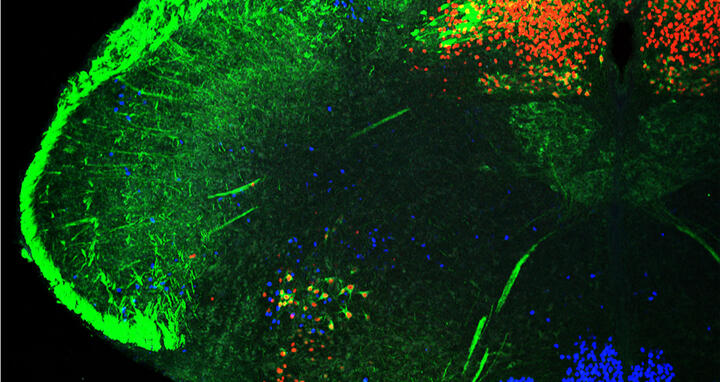“Mummy, I'm here!”
Hardly has the newborn baby mouse escaped the safety of the nest when it notices that it is alone and keeps opening and shutting its mouth. It breathes quickly and jerkily. The salvos of four to six calls it emits have a frequency of 75 kHz, which means they are not audible to the human ear. The mother, however, responds immediately: she goes looking for her lost progeny and reunites it with the rest of the litter. Even when she hears recorded ultrasound calls, she sets off in pursuit.
If a baby mouse in distress is unable to emit these calls, she ignores it. Even though the mother has cleaned and cared for the newborn – and in some cases even sees that it is outside the nest – she does not go and collect it. Experiments show that these mute babies are still left to their own devices 35 minutes later.
A nerve cell nucleus in the brainstem, the nucleus tractus solitarii (NTS), is responsible for ensuring that a newborn mouse can express its discomfort at separation or contact and, in case of emergency, attract its mother’s attention. These are the findings published in the journal PNASby researchers working with Carmen Birchmeier of the Max Delbrück Center for Molecular Medicine in the Helmholtz Association (MDC). Important contributions to the interdisciplinary study were made by the labs of Jean Champagnat in Paris and Gilles Fortin at the CNRS in Gif sur Yvette.
Enough pressure has to be applied to force the air through the vocal folds
“Two groups of neurons have to be coordinated in order to emit the calls: the ones that control tension in the abdominal muscles during exhalation and the ones that are responsible for closing the vocal folds in the larynx,” says MDC researcher Luis Hernandez-Miranda, the lead author of the study and postdoc in Carmen Birchmeier’s lab. This is the only way the biomechanics can work. “Then enough pressure is applied to press the air through the vocal folds – like whistling through your lips.”
In a series of experiments, Hernandez-Miranda and his colleagues have now demonstrated that the NTS in the brainstem must be sufficiently developed to produce these calls.
Mice whose genes for the transcription factors Olig3 or Tlx3 have been modified, either remain mute or only produce sounds very seldom. Researchers therefore investigated which neurons were affected by the mutations and only found an overlap with a single type of nerve cell: dA3. And that, amongst other things, produces the nucleus tractus solitarii.
The innate neural network is crucial for vocalization
The researchers demonstrated that the precursors of the NTS nerve cells are formed on day 10.5 of embryonic development, so they interrupted maturation at precisely this point. And here, they discovered a correlation between the number of existing NTS neurons that had developed nonetheless and the ability to call the mother. Moreover, the team checked its results in a little chamber that registered air pressure changes during the sounds and recorded, using a microphone, the sounds themselves.
The next stage involved proving that the nerve cells in this nucleus really were connected with the motor nerve cells that control tension in the abdominal muscles and vocal folds in the larynx. The nucleus also receives sensory information from the vocal folds, the tongue and the lung. During vocalization, it coordinates sensory inputs and motor outputs.
“That is the mechanism. So, this innate neural network is crucial for vocalization,” says Hernandez-Miranda. As the brainstem is the oldest part of the brain in evolutionary terms, human expression such as laughing, sighing and crying of babies could rest on similar connections. Earlier work had already implied that humans’ ability to swallow and hold their breath is one of the coordination tasks carried out by this nucleus.
The mother ignores the mute newborns
“The mute mice are also a model for investigating the importance of innate vocalization for the interaction between mother and baby,” says Hernandez-Miranda. First tests show that they are essential for survival. When the researchers covered the mute baby mice with bedding, for example, or placed them outside the nest they were not found and brought back by the mother.
“We suspect that the calls are an evolutionarily conserved signal that indicates the offsprings' fitness and health,” Carmen Birchmeier says. Another idea is that the nucleus could be involved in the development and manifestation of speech disorders, which are often seen in patients after strokes, those who have a tumor or are suffering from neurodegenerative diseases.
Further Information
Luis Rodrigo Hernandez-Miranda1, Pierre-Louis Ruffault1, Julien C. Bouvier2, Andrew J. Murray3, Marie-Pierre Morin-Surun2, Niccolò Zampieri1, Justyna B. Cholewa-Waclaw1, Elodie Ey4, Jean-Francois Brunet5, Jean Champagnat2, Gilles Fortin2, and Carmen Birchmeier1 (2017): „Genetic identification of a hindbrain nucleus essential for innate vocalization.“ PNAS. doi:10.1073/pnas.1702893114
1Max-Delbrück-Centrum für Molekulare Medizin in der Helmholtz-Gemeinschaft, Berlin, Germany; 2Paris-Saclay Institute for Neuroscience, CNRS, Gif sur Yvette, France; 3Howard Hughes Medical Institute, Columbia University, New York, USA; 4Pasteur Institute, Paris, France; 5Institut de Biologie de l’École Normale Supérieure, Paris, France







